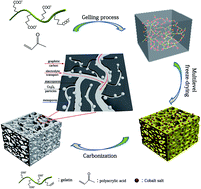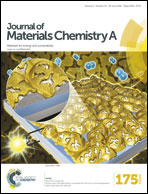Incorporation of homogeneous Co3O4 into a nitrogen-doped carbon aerogel via a facile in situ synthesis method: implications for high performance asymmetric supercapacitors†
Abstract
A novel high-performance electrode material, nitrogen-doped carbon aerogel/cobalt oxide (NCA/Co3O4) material, was prepared by a facile, one step and in situ coating method, followed by a freeze-drying process. The effects of different amounts of Co3O4 on the structural properties, specific surface areas, elemental compositions and electrochemical performance of the composite electrodes were investigated. Consequently, the electrode with 75% mass content of Co3O4 exhibited excellent electrochemical performance, in particular, a high specific capacitance of 616 F g−1 at a current density of 1 A g−1, excellent rate capability (445 F g−1 at 20 A g−1) and outstanding cycle performance. In addition, the asymmetric supercapacitor assembled with NCA/Co3O4-3 and NCA electrodes could be cycled in a high voltage range of 1.5 V and deliver a maximum energy density of 33.43 W h kg−1 at a power density of 375 W kg−1. The enhanced electrochemical performance is attributed to the complementary contributions of the 3D interconnected porous structure and the efficient pseudocapacitance of the uniformly dispersed Co3O4 nanoparticles. The preparation method offers a new fabrication strategy to in situ fabricate carbon-supported metal oxide electrodes for high-performance energy storage applications.


 Please wait while we load your content...
Please wait while we load your content...